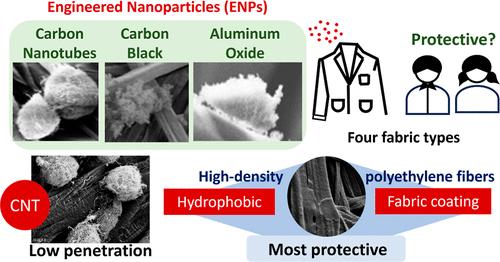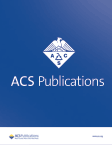Potential Penetration of Engineered Nanoparticles under Practical Use of Protective Clothing Fabrics
IF 3.4
Q2 PUBLIC, ENVIRONMENTAL & OCCUPATIONAL HEALTH
引用次数: 0
Abstract
The commercial application of engineered nanoparticles (ENPs) has rapidly increased as their unique properties are useful to improve many products. ENPs, however, can pose a major health risk to workers through exposure routes such as inhalation and dermal contact. Research is lacking on the protective nature of lab coats when challenged with ENPs. This study investigated multiwalled carbon nanotubes (CNTs), carbon black (CB), and nano aluminum oxide (Al2O3) penetration through four types of lab coat fabrics (cotton, polypropylene, polyester cotton, and Tyvek). Penetration efficiency was determined with direct reading instruments. The front and back of contaminated fabric swatches were further assessed with microscopy analysis to determine fabric structure with contaminated and penetrated particle morphology and level of fabric contamination. Fabric thickness, porosity, structure, surface chemistry, and ENP characteristics such as shape, morphology, and hydrophobicity were assessed to determine the mechanisms behind particle capture on the four common fabrics. CNTs penetrated all fabrics significantly less than the other ENPs. CNT average penetration across all fabrics was 1.83% compared to 15.74 and 11.65% for CB and Al2O3, respectively. This can be attributed to their fiber shape and larger agglomerates than those of other ENPs. Tyvek fabric was found to be the most protective against CB and Al2O3 penetration, with an average penetration of 0.06 and 0.11%, respectively, while polypropylene was the least protective with an average penetration of 40.36 and 15.77%, respectively. Tyvek was the most nonporous fabric with a porosity of 0.50, as well as the most hydrophobic fabric, explaining the low penetration across all three ENPs. Polypropylene is the most porous fabric with a porosity of 0.77, making it the least protective against ENPs. We conclude that porosity, fabric structure, and thickness are more important fabric characteristics to consider when discussing particle penetration through protective clothing fabrics than surface chemistry.

工程纳米粒子在防护服织物实际使用中的潜在渗透性
由于工程纳米粒子(ENPs)的独特性能有助于改进许多产品,因此其商业应用迅速增加。然而,ENPs 可通过吸入和皮肤接触等途径对工人的健康造成重大威胁。目前还缺乏对实验服在受到 ENPs 挑战时的保护性质的研究。本研究调查了多壁碳纳米管 (CNT)、炭黑 (CB) 和纳米氧化铝 (Al2O3) 在四种白大褂织物(棉、聚丙烯、聚酯棉和特卫强)中的渗透情况。渗透效率用直读仪器测定。受污染织物色样的正面和背面通过显微镜分析进行进一步评估,以确定受污染和穿透颗粒形态的织物结构以及织物污染程度。对织物厚度、孔隙率、结构、表面化学以及 ENP 特性(如形状、形态和疏水性)进行了评估,以确定颗粒在四种常见织物上的捕获机制。与其他 ENP 相比,CNT 对所有织物的穿透力都明显较低。CNT 在所有织物上的平均渗透率为 1.83%,而 CB 和 Al2O3 的渗透率分别为 15.74% 和 11.65%。这可归因于它们的纤维形状和比其他 ENP 更大的团聚体。研究发现,特卫强织物对 CB 和 Al2O3 的渗透保护作用最强,平均渗透率分别为 0.06% 和 0.11%,而聚丙烯的保护作用最小,平均渗透率分别为 40.36% 和 15.77%。特卫强是最无孔隙的织物,孔隙率为 0.50,同时也是最疏水的织物,这也是所有三种 ENP 渗透率较低的原因。聚丙烯是最多孔的织物,孔隙率为 0.77,因此对 ENP 的防护能力最弱。我们的结论是,在讨论微粒穿透防护服织物时,孔隙率、织物结构和厚度是比表面化学性质更重要的织物特征。
本文章由计算机程序翻译,如有差异,请以英文原文为准。
求助全文
约1分钟内获得全文
求助全文
来源期刊

ACS Chemical Health & Safety
PUBLIC, ENVIRONMENTAL & OCCUPATIONAL HEALTH-
CiteScore
3.10
自引率
20.00%
发文量
63
期刊介绍:
The Journal of Chemical Health and Safety focuses on news, information, and ideas relating to issues and advances in chemical health and safety. The Journal of Chemical Health and Safety covers up-to-the minute, in-depth views of safety issues ranging from OSHA and EPA regulations to the safe handling of hazardous waste, from the latest innovations in effective chemical hygiene practices to the courts'' most recent rulings on safety-related lawsuits. The Journal of Chemical Health and Safety presents real-world information that health, safety and environmental professionals and others responsible for the safety of their workplaces can put to use right away, identifying potential and developing safety concerns before they do real harm.
 求助内容:
求助内容: 应助结果提醒方式:
应助结果提醒方式:


